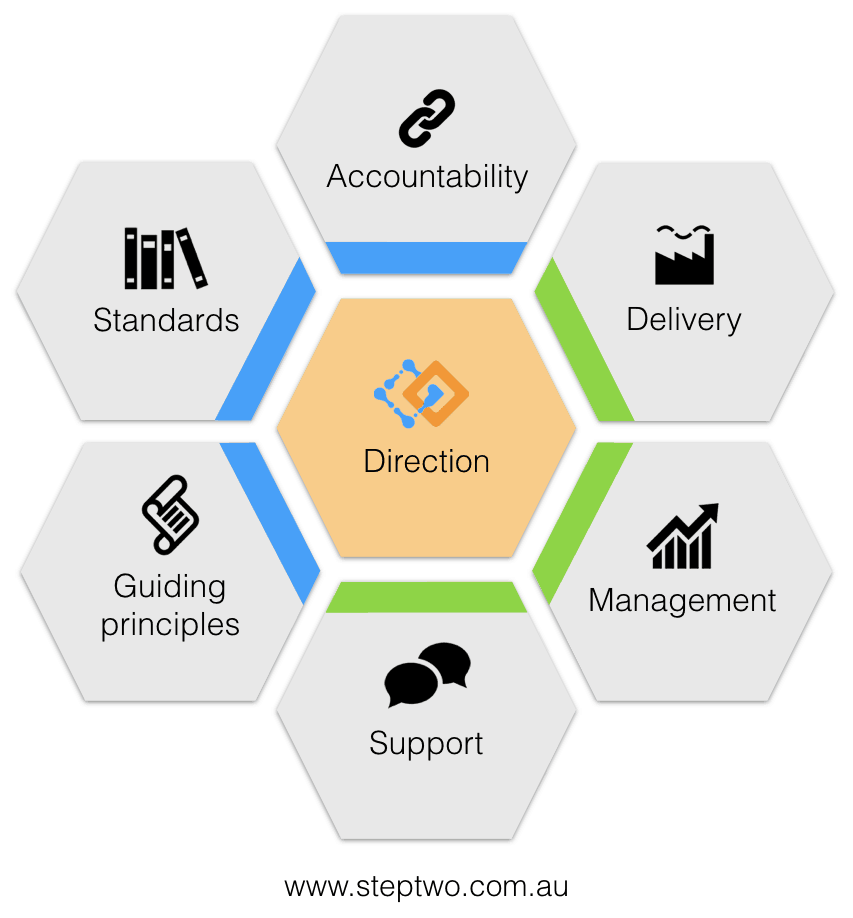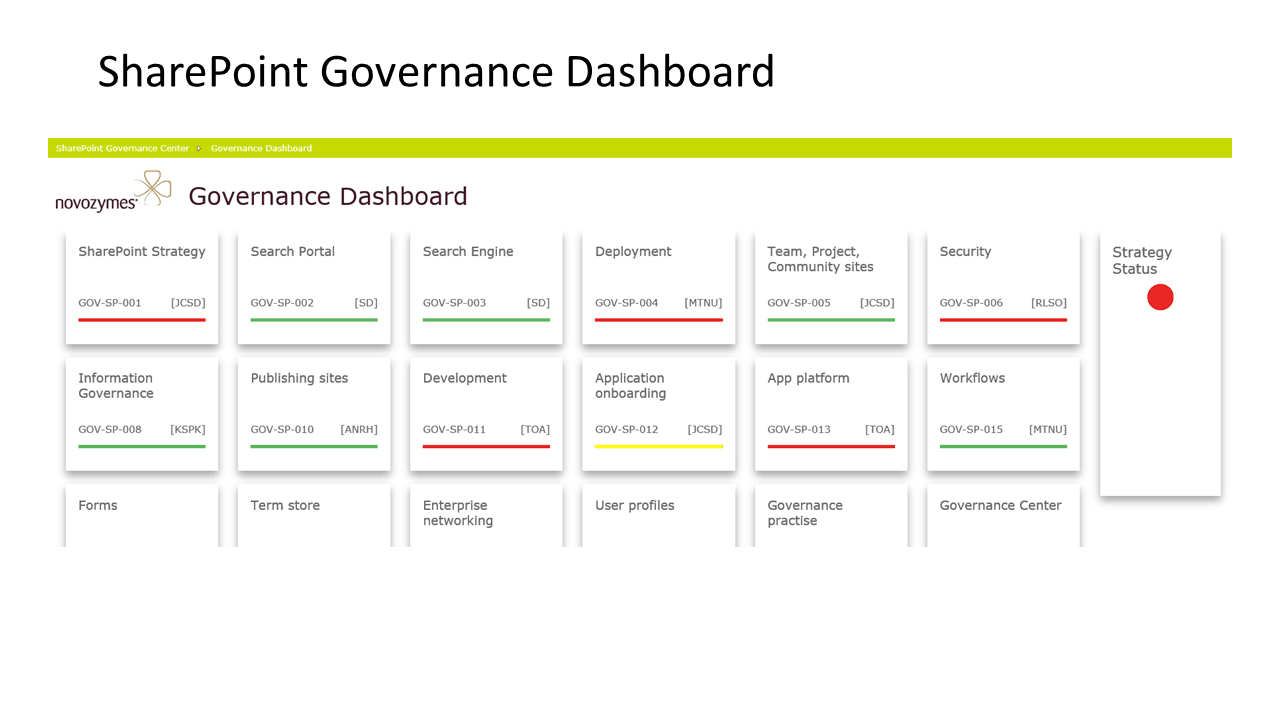
Filed under: Intranets
Governance is a word that looms large in the intranet and digital workplace world, and a topic that we’ve covered numerous times. It’s also a concept that some teams struggle with and can even find intimidating.
Establishing intranet governance can seem like a huge, unwieldy task that is difficult to achieve on top of all the other things that need to be done. Some teams can also feel uncomfortable trying to enforce it, particularly when it’s time to play the reluctant police force and lay down the law to your stakeholders and users about some rules and processes.
Before we go on, it’s worth defining exactly what governance is – it’s a word which can be easily misunderstood. Nearly ten years ago we described the essence of governance as:
“having a framework in place that enables the decision-making and planning processes for the intranet. This provides support for the intranet team and assists with the smooth running of the intranet.”
This framework needs to address elements such as ownership, sponsorship, processes, roles, structures, content management, publishing standards, information security, rules and more.
It can take time and effort to set up robust and effective intranet governance. There will also always be a few people who are going to be obstinate and refuse to toe the line, but there are some approaches and practices teams can carry out to make governance considerably less scary and feel far more achievable. Here are seven key approaches.
1. Break it down into constituent parts
Like any big project that has the potential to be overwhelming, breaking governance down into different constituent parts and considering your approach and actions separately across different elements always make it more manageable.
A useful way to break governance down is to consider it as your overall operating model, where the different elements work together to deliver a successful, sustainable and well-adopted intranet. Here at Step Two we’ve developed an operating model that we frequently use with our clients, which breaks down governance as operating model into seven elements – Accountability, Delivery, Management, Support, Guiding Principles, Standards, with Direction at the centre.

The Intranet Operating Model, created by Step Two.
When you consider governance as a series of more manageable, interlinking aspects, it’s easier to make progress by prioritising actions and moving forward. In our view, some governance is better than no governance, and realistically most teams won’t be able to design and implement everything overnight.
2. Make change management a part of governance
James Robertson described governance as ‘a living thing that seeks to build consensus and cohesion’. With organisations constantly restructuring and adapting, employees moving on, new employees coming in, new technology being rolled out and user expectations and needs in a state of flux, governance does need to adapt and continue to be promoted to make it truly sustainable.
Change management through communications, training, support and engagement activity is critical to governance working and helping to build and maintain the consensus it needs. In the ‘Delivery’ part of Step Two’s operating model, we regard having a change management methodology as critical for any effective system which can respond to the ever-changing needs of users, teams and organisations.
Communicating governance in the right way is key. Sometimes ‘governance’ may not be the right word. Let’s be honest, it sounds pretty dry and boring. If you branded your governance framework as the ‘Intranet Success Framework’ for example, would it be received differently by your stakeholders?
As well as communications, it’s also important that central teams support local content managers. Many teams have excelled in change management to support governance, for example:
- Philips supporting content teams maintaining standards and findability for a new topic-based intranet
- GSK supporting site managers to switch to a new template for SharePoint
- PANDORA budgeting for a global intranet and digital workplace training program.
3. Sell tangible benefits to senior stakeholders
Change management efforts also need to include senior management. To make your governance work you need to sell the benefits of it to your stakeholders, especially senior stakeholders. When senior management are bought-in, it gets considerably easier to implement governance as less senior people are more likely to comply with your governance framework.
Getting buy-in involves making people understand why you are putting your roles, rules, policies, structures and other parts of your framework in place. Sometimes, the connection between the minutiae of a process, such as why a request for a new collaboration site requires a form to be filled in, and the wider goals of the collaboration platform, are not obvious. Therefore you need to sell the tangible benefits of what you want to implement.
In our experience, selling governance to senior stakeholders is often about getting time in their diaries, talking one-to-one, sounding them out early and understanding what’s in it for them. Tangible outcomes will resonate with them more strongly. For example, biotechnology company Shire introduced strong governance early on in their global intranet project to help lock down several standard templates which could be re-used for different sites across the intranet. This really helped to reduce costs but still delivered on their communication ambitions for the platform – the type of message which goes down very well with senior stakeholders.
Meanwhile a new governance process around mobile apps at McKesson had the very tangible outcome of new apps appearing in the corporate app store which had also had all the necessary risk and compliance processes carried out – another argument which ticks the boxes of senior executives.
4. Make sure governance fits your culture
An important reality check for whether governance is sustainable is whether it fits with your organisational culture. For example, if everybody is very risk-averse then you may not be able to enforce something which is quite loose and decentralised. In an organisation where teams, departments or divisions tend to have a lot of autonomy, you might not be able to enforce something which is very rigid, centralised and process-heavy, despite the benefits.
It’s also worth considering that organisational culture is rarely homogeneous and something you might be able to successfully implement in one part of the company might not work in another. For example, Novozymes has done an excellent job of driving a very thorough and innovative SharePoint governance framework, but something that detailed will not be suitable for every organisation.

Novozymes SharePoint governance dashboard. Screenshot appears courtesy of Novozymes.
5. Get the timing right
If you’re introducing a new intranet governance framework, getting the timing right can be key, especially the way the timing relates to a larger intranet or digital workplace project or initiative. For example, introducing governance before or during your project may not only contribute to its success, but it will also give a logic and rationale to your efforts which will help you engage stakeholders and groups.
Any large intranet project usually involves an intense content review, migration and creation process. Having good content governance established with owners, standards and so on well before the project starts will make life easier for everybody. Likewise getting senior sponsors interested in joining a steering group is usually more likely when a new intranet is on the horizon. However, it is also important to keep on engaging them as the intranet slips into ‘business as usual’.
6. Write it down and make it available
If there is one tip you take away from this article, then let it be to document your governance processes, roles, standards and rules and then make them available for all to see. The obvious place for these is the intranet itself.
It might not be the most urgent thing on your to-do list, but rules and roles will always remain ad hoc and informal until you write them down. And if you don’t make them available, people will not be able to follow them.
Documenting your practices has several other advantages:
- Formalising your governance arrangements gives them more gravitas and stakeholders will take them more seriously
- The documentation process can help you identify gaps, spot synergies and develop your thinking on better governance
- You’re far more likely to keep it all up to date
- Documentation can usually form the basis for learning assets.
7. Ensure everything is sustainable
Any governance is a system and the system needs to last if it’s going to have an impact. Therefore what you do has to be sustainable, or at least sustainable to the best of your ability. All of the approaches above should make governance sustainable.
Whatever systems you set up need to be considered and assessed as to whether they will last. Ask yourself questions such as:
- Do the central team have the resources to do what I’m asking them to do?
- Do devolved roles have the skills and the time to commit to what is being asked of them?
- What will happen if there are changes in personnel?
- Do I have a process in place to cope with that?
- If an individual doesn’t play ball and refuses to comply, do I have the clout to respond?
If the answer to any of these questions is no, then you need to change your governance plans and perhaps scale back to something more realistic. Again, work on the principle that some governance is better than no governance.
Governance doesn’t need to be scary
Intranet governance doesn’t need to be scary. There are many practical approaches you can take so that governance is more likely to be sustainable, will resonate with your stakeholders and users and ultimately lead to a more successful intranet. It’s also worth remembering that no system is ever perfect and it is likely to always need improving. Working on implementing governance is part of an intranet team’s core activity and one of the ways you bring value to the organisation you work in.





